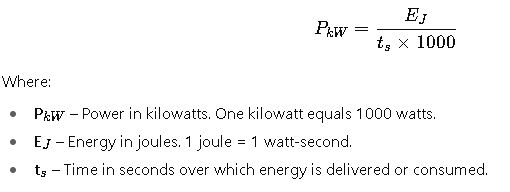Understanding the relationship between energy and power is essential in scientific, engineering, and practical contexts. This guide explores converting joules (J) to kilowatts (kW), including formulas, examples, and applications.
Joules ↔ Kilowatts Calculator
Convert energy (Joules) to power (kW) using a time interval — or convert kW back to Joules. Clear formulas, instant results, SEO-ready FAQ included.
How does Joules → kW work?
How to convert kW → Joules?
Formulas used
kW → J: J = kW × 1000 × t where t is seconds.
Joules to Kilowatts Conversion Formula
The conversion from joules to kilowatts involves understanding the relationship between energy and power. Power is the rate at which energy is used or produced, and it is defined as:
P (kW) = E (J) / (t (s) × 1000)
Where:
- P (kW) = Power in kilowatts
- E (J) = Energy in joules
- t (s) = Time in seconds
This formula indicates that to find the power in kilowatts, divide the energy in joules by the product of time in seconds and 1000. The factor of 1000 converts joules to kilojoules, aligning with the kilowatt unit.
Conversion Table: Joules to Kilowatts
To facilitate quick conversions, here’s a table illustrating the relationship between energy in joules and power in kilowatts over various time intervals:
| Energy (J) | Time (s) | Power (kW) |
|---|---|---|
| 1 | 1 | 0.001 |
| 10 | 1 | 0.01 |
| 100 | 1 | 0.1 |
| 1,000 | 1 | 1 |
| 10,000 | 1 | 10 |
| 100 | 10 | 0.01 |
| 1,000 | 10 | 0.1 |
| 10,000 | 10 | 1 |
| 100,000 | 10 | 10 |
| 1,000,000 | 10 | 100 |
This table demonstrates how the power in kilowatts increases with higher energy values and shorter time durations.
Real-World Applications
1. Electric Vehicle Battery Discharge
Consider an electric vehicle (EV) battery with a capacity of 36,000,000 joules (36 MJ). If the battery discharges this energy over 10 hours (36,000 seconds), the power output can be calculated as:
P (kW) = 36,000,000 J / (36,000 s × 1000) = 1 kW
This means the EV operates at a constant power of 1 kilowatt during the discharge period.
2. Solar Panel Energy Output
A solar panel generates 500,000 joules of energy per hour. To determine the power output in kilowatts:
P (kW) = 500,000 J / (3,600 s × 1000) ≈ 0.139 kW
This indicates that the solar panel produces approximately 0.139 kilowatts of power continuously over the hour.
Detailed Formulas and Their Components
Converting joules to kilowatts often requires understanding multiple related formulas in energy and power systems. Below is a comprehensive breakdown.
1. Basic Joules to kW Formula

Explanation:
- Joules represent energy, while kilowatts represent power (energy per unit time).
- The division by 1000 converts watts to kilowatts.
2. Using Kilowatt-Hours
Sometimes, energy is measured in kWh, which is more common in electricity billing. The relationship between joules and kilowatt-hours is:

This confirms the consistency of the basic formula with real-world energy metrics.
3. Instantaneous vs Average Power
Instantaneous Power (for dynamic systems):
- dE – Infinitesimal energy change.
- dt – Infinitesimal time interval.
Average Power:

Understanding the difference is critical in systems like pulsed lasers or intermittent power generation.
Expanded Conversion Table: Joules to Kilowatts
To give more practical guidance, here’s an extensive table covering a wide range of energy values and time intervals:
| Energy (J) | Time (s) | Power (kW) |
|---|---|---|
| 500 | 1 | 0.5 |
| 1,000 | 1 | 1 |
| 5,000 | 1 | 5 |
| 10,000 | 1 | 10 |
| 50,000 | 10 | 5 |
| 100,000 | 10 | 10 |
| 500,000 | 60 | 8.33 |
| 1,000,000 | 60 | 16.67 |
| 5,000,000 | 300 | 16.67 |
| 10,000,000 | 600 | 16.67 |
| 36,000,000 | 36,000 | 1 |
| 72,000,000 | 36,000 | 2 |
| 100,000,000 | 50,000 | 2 |
| 500,000,000 | 100,000 | 5 |
Insights:
- Higher energy values produce higher kilowatt outputs over shorter durations.
- The same energy spread over longer times results in lower power levels.
Real-World Examples in Engineering
Example 1: Industrial Motor Operation
Scenario: A factory motor consumes 1,800,000 J of electrical energy over 30 minutes (1,800 seconds). Determine the power in kilowatts.
Solution:
Interpretation: The motor operates at an average power of 1 kW, which is crucial for selecting the correct circuit breaker and wiring.
Example 2: Battery Storage for Renewable Systems
Scenario: A solar battery stores 72 MJ of energy, discharging over 12 hours (43,200 seconds). Find the average power output in kW.
Calculation:
Interpretation:
- The solar system can continuously supply 1.667 kW.
- This data is critical for sizing inverters and load management in a renewable microgrid.
Applications Across Fields
- Electric Vehicles: Calculate battery discharge rate to estimate range and performance.
- Industrial Machinery: Determine average power consumption for motors, heaters, and compressors.
- Renewable Energy Systems: Analyze solar, wind, or hydro energy output in real-time.
- HVAC Systems: Convert energy consumption in joules to power ratings for efficient energy management.
- Pulsed Energy Systems: Lasers and welding machines require instantaneous power calculations.
Practical Tips for Accurate Conversion
- Always maintain unit consistency: joules for energy, seconds for time.
- For billing or grid-scale systems, use kWh, noting that 1 kWh = 3.6 × 10^6 J.
- When measuring dynamic power, consider instantaneous vs average calculations.
- For engineering designs, round kW to two decimals for practical application.
- Use software calculators for large datasets or continuous monitoring systems.


